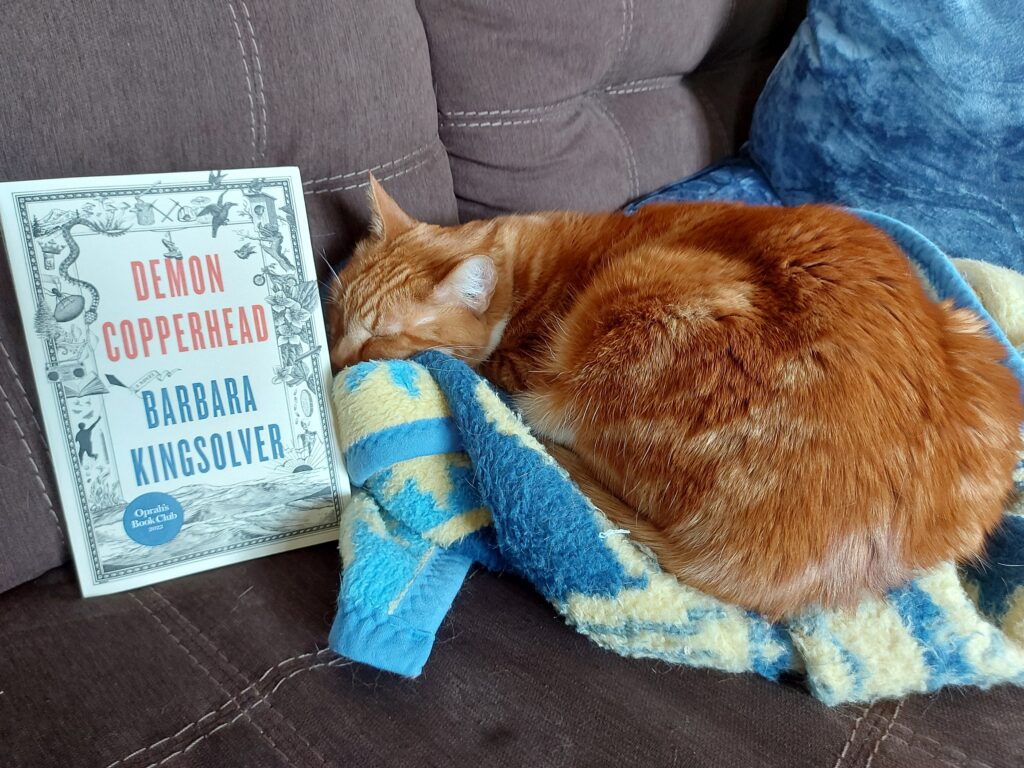Demon Copperhead by Barbara Kingsolver

Demon Copperhead is a modern take on Charles Dickens’s David Copperfield – they have a similar narrative structure and many of the characters have the same names. Demon Copperhead is set in the 1990s and early 2000s and is about an orphaned boy caught up in the opioid crisis in the poor mining communities targeted by Purdue Pharma (the makers of OxyContin). The protagonist is Damon Fields, nicknamed Demon Copperhead because of the copper-coloured hair he inherited from his father who died before he was born, who grows up in Lee County, Virginia. Demon Copperhead, like David Copperfield, is a likeable character that you want to root for, but unlike David, Demon tends towards self-destruction instead of striving to change his situation, which is understandable growing up in a part of the country that has been ravaged by opioids and made the butt of many hillbilly jokes. Demon Copperhead is a heavy read, but I think it is a great novel.
This is the first novel by Barbara Kingsolver that I have read, and I am impressed by her authentic depiction of a young man growing up in Appalachia. Demon Copperhead is narrated by Demon himself in an engaging voice characterized by simple and direct diction. The story begins with Demon’s birth; he is born of a single teenage mother struggling to stay sober. He and his mother live in a trailer next door to the Peggots, who are raising their grandson, Matthew aka Maggot, who is the same age as Demon and whose mother is in prison. Demon’s early childhood is as idyllic as it can be considering his mom keeps relapsing on drugs and getting sent to rehab while he stays with the Peggots and plays with Maggot. But when he is nine, his mother marries an abusive man who hates Demon. Demon is sent to foster care when a nasty family fight causes his mom to relapse again and get sent to rehab. The first of Demon’s foster homes is “Creaky Farm” and the creepy old man who owns the farm only takes in foster kids when he needs money and free labour.
Demon’s life goes downhill from there. After his mom is out of rehab, he is not allowed to go home and is only allowed supervised visits with his mom. Then, on his tenth birthday, he finds out that his mom has overdosed and died.
Dickens’ David Copperfield is about the damaging effects of poverty on children, and Kingsolver’s Demon Copperhead shows that nothing has changed since Dickens’s time in that regard. With his mother dead and the Peggots unable to take him in, Demon is shunted into a foster care system that does not care about children, from the underpaid and apathetic social workers to the foster parents who game the system for money that they do not even spend on the kids in their care. Demon is never fed enough and is poorly clothed. He is forced into a menial job at a very young age where he must give his earnings to his foster parents, and as a result becomes indifferent towards his own education.
An injury that occurs at a bright moment in his life sends teenager Demon spiralling when he is recklessly prescribed opioids by a dirty doctor who runs a pill farm. He becomes a drug addict, just like his mom. But it is not just him. All around him, Demon’s peers, many of them also the orphaned children of drug addicts, are succumbing to drug addiction and giving up on the bright futures they might have had. Demon Copperhead depicts a vicious generational cycle of poverty and drug addiction that people who live outside rural communities cannot seem to comprehend. It is easier to make fun of the “ignorant hicks” without examining the exploitation and prejudices that keep them down.
But as depressing as Demon’s story can be, Kingsolver wants us to have hope. With support and determination, drug addicts have been able to break the cycle and get themselves clean. Demon Copperhead may feel like there is no hope for him, but ultimately his story is anything but hopeless.